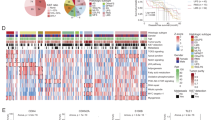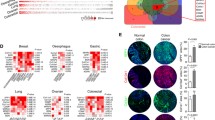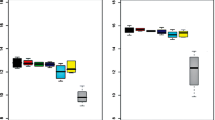Abstract
We applied reverse phase protein microarrays technology to map signal pathway interactions in a discovery set of 34 soft tissue sarcoma (STS) bone metastases compared to healthy bone. Proteins associated with matrix remodeling (MMP), adhesion (FAK Y576/577, Syndecan-1), and growth/survival (IGF1R Y1135/1136, PI3K, EGFR) were elevated in metastasis compared to normal bone. Linkage between Syndecan-1, FAK Y576/577, Shc Y317, and EGFR, IGF Y1135/1136, PI3K/AKT was a prominent feature of STS bone metastasis. Elevated linkage between RANKL and 4EBP1 T37/46, EGFR, IGF1R Y1135/1136, Src Y41, Shc Y317, PI3Kp110γ was associated with short survival. Finally, we tested the hypothesis that signal pathway proteins augmented in the STS bone metastasis may provide clues to understand the subset of primary STS that metastasize. The most representative molecules identified in the discovery set were validated on an independent series of 82 primary STS by immunohistochemistry applied to a tissue microarray. The goal was to correlate the molecular profile in the primary tumors with a higher likelihood of metastasis. Elevation of activated kinase substrate endpoints IRS1 S612, 4EBP1 T37/46, FAK Y576/577 and loss of Fibronectin, were associated with a higher likelihood of metastases. These data indicate that the linkage between matrix remodeling, adhesion, and growth signaling may drive STS metastasis and can be the basis for prognostic and therapeutic strategies.


Similar content being viewed by others
References
Campanacci M (1999) Introduction. Bone and soft tissue tumors: clinical features, imaging, pathology and treatment, 2nd edn. Piccin Nuova Libraria, Padova, pp 18–29
Wu JS, Hochman MG (2009) Soft-tissue tumors and tumor like lesions: a systematic imaging approach. Radiology 253(2):297–316
Kind M, Stock N, Coindre JM (2009) Histology and imaging of soft tissue sarcomas. Eur J Radiol 72(1):6–15
van Vliet M, Kliffen M, Krestin GP, van Dijke CF (2009) Soft tissue sarcomas at a glance: clinical, histological, and MR imaging features of malignant extremity soft tissue tumors. Eur Radiol 19(6):1499–1511
Murphey MD (2007) World Health Organization classification of bone and soft tissue tumors: modifications and implications for radiologists. Semin Muscoloskelet Radiol 11(3):201–214
Frassica FJ, Khanna JA, McCarthy EF (2000) The role of MR imaging in soft tissue tumor evaluation: perspective of the orthopedic oncologist and musculoskeletal pathologist. Magn Reson Imaging Clin N Am 8(4):915–927
Lee YF, John M, Falconer A, Edwards S, Clark J, Flohr P, Roe T, Wang R, Shipley J, Grimer RJ, Mangham DC, Thomas JM, Fisher C, Judson I, Cooper CS (2004) A gene expression signature associated with metastatic outcome in human leiomyosarcomas. Cancer Res 64:7201–7204
Casimiro S, Guise TA, Chirgwin J (2009) The critical role of the bone microenvironment in cancer metastases. Mol Cell Endocrinol 310(1–2):71–81
Lynch CC (2010) Matrix metalloproteinases as master regulators of the vicious cycle of bone metastasis. Bone 48:44–53
Chiechi A, Novello C, Magagnoli G, Petricoin EF III, Deng J, Benassi MS, Picci P, Vaisman I, Espina V, Liotta LA (2013) Elevated TNFR1 and serotonin in bone metastasis are correlated with poor survival following bone metastasis diagnosis for both carcinoma and sarcoma primary tumors. Clin Cancer Res 19(9):2473–2485
Sheehan KM, Calvert VS, Kay EW, Lu Y, Fishman D, Espina V, Aquino J, Speer R, Araujo R, Mills GB, Liotta LA, Petricoin EF III, Wulfkuhle JD (2005) Use of reverse phase protein microarrays and reference standard development for molecular network analysis of metastatic ovarian carcinoma. Mol Cell Proteomics 4:346–355
Chiechi A, Mueller C, Boehm KM, Romano A, Benassi MS, Picci P, Liotta LA, Espina V (2012) Improved data normalization methods for reverse phase protein microarray analysis of complex biological samples. Biotechniques 1–7
Romeo S, Bovée JV, Kroon HM, Tirabosco R, Natali C, Zanatta L, Sciot R, Mertens F, Athanasou N, Alberghini M, Szuhai K, Hogendoorn PC, Dei Tos AP (2012) Malignant fibrous histiocytoma and fibrosarcoma of bone: a re-assessment in the light of currently employed morphological, immunohistochemical and molecular approaches. Virchows Arch 461(5):561–570
Lee JA, Jung JS, Kim DH, Lim JS, Kim MS, Kong CB, Song WS, Cho WH, Jeon DG, Lee SY, Koh JS (2011) RANKL expression is related to treatment outcome of patients with localized, high-grade osteosarcoma. Pediatr Blood Cancer 56:738–743
Hall CL, Keller ET (2006) The role of Wnts in bone metastases. Cancer Metastasis Rev 25(4):551–558
Santini D, Galluzzo S, Zoccoli A, Pantano F, Fratto ME, Vincenzi B, Lombardi L, Gucciardino C, Silvestris N, Riva E, Rizzo S, Russo A, Maiello E, Colucci G, Tonini G (2012) New molecular targets in bone metastases. Cancer Treat Rev 36(3):S6–S10
Péterfia B, Füle T, Baghy K, Szabadkai K, Fullár A, Dobos K, Zong F, Dobra K, Hollósi P, Jeney A, Paku S, Kovalszky I (2012) Syndecan-1 enhances proliferation, migration and metastasis of ht-1080 cells in cooperation with syndecan-2. PLoS One. doi:10.1371/journal.pone.0039474
Barbareschi M, Maisonneuve P, Aldovini D, Cangi MG, Pecciarini L, Angelo Mauri F, Veronese S, Caffo O, Lucenti A, Palma PD, Galligioni E, Doglioni C (2003) High syndecan-1 expression in breast carcinoma is related to an aggressive phenotype and to poorer prognosis. Cancer 98:474–483
Kelly T, Suva LJ, Nicks KM, MacLeod V, Sanderson RD (2010) Tumor derived Syndecan-1 mediates distal cross-talk with bone and enhances osteoclastogenesis. J Bone Miner Res 25:1295–1304
Wang D, Grammer JR, Cobbs CS, Stewart JE Jr, Liu Z, Rhoden R, Hecker TP, Ding Q, Gladson CL (2000) p125 focal adhesion kinase promotes malignant astrocytoma cell proliferation in vivo. J Cell Sci 113:4221–4230
Hecker TP, Grammer JR, Gillespie GY, Stewart J Jr, Gladson CL (2002) Focal adhesion kinase enhances signaling through the shc/extracellular signal regulated kinase pathway in anaplastic astrocytoma tumor biopsy samples. Cancer Res 62:2699–2707
Samani AA, Yakar S, LeRoith D, Brodt P (2007) The role of the IGF system in cancer growth and metastasis: overview and recent insights. Endocr Rev 28(1):20–47
Singh P, Carraher C, Schwarzbauer JE (2010) Assembly of fibronectin extracellular matrix. Cell Dev Biol 26:397–419
Roebuck MM, Helliwell TR, Chaudhry IH, Kalogrianitis S, Carter S, Kemp GJ, Ritchie DA, Jane MJ, Frostick SP (2005) Matrix metalloproteinase expression is related to angiogenesis and histologic grade in spindle cell soft tissue neoplasms of extremities. Am J Clin Pathol 123:405–414
Martelli AM, Nyåkern M, Tabellini G, Bortul R, Tazzari PL, Evangelisti C, Cocco L (2006) Phosphoinositide 3-kinase/Akt signaling pathway and its therapeutical implications for human acute myeloid leukemia. Leukemia 20(6):911–912
Vivanco I, Sawyers CL (2002) The phosphatidylinositol 3-Kinase AKT pathway in human cancer. Nat Rev Cancer 2(7):489–501
Gingras AC, Raught B, Gygi SP, Niedzwiecka A, Miron M, Burley SK, Polakiewicz RD, Wyslouch-Cieszynska A, Aebersold R, Sonenberg N (2001) Hierarchical phosphorylation of the translation inhibitor 4E-BP1. Genes Dev 15:2852–2864
Ren W, Korchin B, Zhu QS, Wei C, Dicker A, Heymach J, Lazar A, Pollock RE, Lev D (2800) Epidermal growth factor receptor blockade in combination with conventional chemotherapy inhibits soft tissue sarcoma cell growth in vitro and in vivo. Clin Cancer Res 14:2785–2795
Wittrant Y, Theoleyre S, Chipoy C, Padrines M, Blanchard F, Heymann D, Rédini F (2004) RANKL/RANK/OPG: new therapeutic targets in bone tumours and associated osteolysis. Biochim Biophys Acta 1704:49–57
Lipton A, Steger GG, Figueroa J, Alvarado C, Solal-Celigny P, Body JJ, de Boer R, Berardi R, Gascon P, Tonkin KS, Coleman RE, Paterson AH, Gao GM, Kinsey AC, Peterson MC, Jun S (2008) Extended efficacy and safety of denosumab in breast cancer patients with bone metastases not receiving prior bisphosphonate therapy. Clin Cancer Res 14:6690–6696
Acknowledgments
We are grateful to Ms. Cristina Ghinelli for the graphics, Dr. Elettra Pignotti for statistical analysis, Dr. Alba Balladelli for editing and the Rizzoli Institute surgical pathology technicians. This work was supported by: George Mason University and the Italian Istituto Superiore di Sanità in the framework of the Italy/USA cooperation agreement between U.S department of Health and Human Service, George Mason University and the Italian Ministry of Public Health; Chiara Novello was supported by Grant 13748 from Fondazione Italiana per la Ricerca sul Cancro (FIRC).
Conflict of interest
The authors declare that they have no conflict of interest.
Author information
Authors and Affiliations
Corresponding author
Electronic supplementary material
Below is the link to the electronic supplementary material.
Rights and permissions
About this article
Cite this article
Conti, A., Espina, V., Chiechi, A. et al. Mapping protein signal pathway interaction in sarcoma bone metastasis: linkage between rank, metalloproteinases turnover and growth factor signaling pathways. Clin Exp Metastasis 31, 15–24 (2014). https://doi.org/10.1007/s10585-013-9605-6
Received:
Accepted:
Published:
Issue Date:
DOI: https://doi.org/10.1007/s10585-013-9605-6




